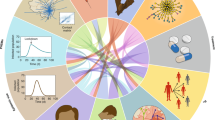
Overview
- Introduces the most recent framework to contagion process modeling
- Features different levels of readability (from the simplest introductory one to the expert algorithmic one) according to the background of the reader
- Technical details are reported in specific ‘infoboxes’
- Contains an atlas of possible pandemics that can be explored by the reader and related to past and future events
Access this book
Tax calculation will be finalised at checkout
Other ways to access
About this book
The first part of the book guides the reader through sophisticated complex systems modeling techniques with a non-technical and visual approach, explaining and illustrating the construction of the modern framework used to project the spread of pandemics and epidemics. Models can be used to transform data to knowledge that is intuitively communicated by powerful infographics and for this reason, the second part of thebook focuses on a set of charts that illustrate possible scenarios of future pandemics. The visual atlas contained allows the reader to identify commonalities and patterns in emerging health threats, as well as explore the wide range of models and data that can be used by policy makers to anticipate trends, evaluate risks and eventually manage future events.
Charting the Next Pandemic puts the reader in the position to explore different pandemic scenarios and to understand the potential impact of available containment and prevention strategies. This book emphasizes the importance of a global perspective in the assessment of emerging health threats and captures the possible evolution of the next pandemic, while at the same time providing the intelligence needed to fight it. The text will appeal to a wide range of audiences with diverse technical backgrounds.
Similar content being viewed by others
Keywords
Table of contents (6 chapters)
-
Front Matter
-
HOW TO MODEL PANDEMICS
-
Front Matter
-
-
PANDEMIC CHARTS
-
Front Matter
-
-
Back Matter
Reviews
“This book is rather informative about what it takes to appropriately model the rise and spread of an infectious disease. It is useful in highlighting what types of data are needed to model these complex disease processes and how to properly incorporate these variables into model building.” (Eric S. Kontowicz, Doody's Book Reviews, March, 22 , 2019)
Authors and Affiliations
About the authors
Nicola Perra is a Senior Lecturer in network science at the University of Greenwich, UK. His research interests revolve around the study of human dynamics, digital epidemiology, and network science.
Luca Rossi is a Senior Researcher at the Institute for Scientific Interchange in Torino, Italy. Luca’s research focuses on the mathematical and computational modeling of contagion processes in structured populations, in particular human transmittable infectious diseases.
Nicole Samay is a Senior Graphic Designer in the NetworkScience Institute at Northeastern University in Boston. She works with researchers to develop and adapt data visualizations, with a particular focus on information design and spreading processes.
Alessandro Vespignani is the Sternberg Distinguished Professor at Northeastern University in Boston. He is Fellow of the American Physical Society, member of the Academy of Europe, and Fellow of the Institute for Quantitative Social Sciences at Harvard University. Vespignani is focusing his research activity in modeling diffusion phenomena in complex systems, including data-driven computational approaches to infectious diseases spread.
With
Corrado Gioannini worked for several years in the private sector, in IT companies, developing his skills in software development and management. He is now a research leader at the Complex Systems and Networks group at ISI Foundation, where he coordinates the development of the GLEAMviz Simulator software framework.
Marcelo F. C. Gomes is a researcher on infectious disease modeling and surveillance at Fundação Oswaldo Cruz’s Scientific Computing Program (Fiocruz, PROCC). His main research focus is on combining reported cases from public health agencies and human mobility for the development of risk analysis and nowcasting tools.
Bruno Gonçalves is a Moore-Sloan Fellow at NYU’s Center for Data Science. With a background in Physics and Computer Science, his career has revolved around the use of datasets from sources as diverse as Apache web logs, Wikipedia edits, Twitter posts, Epidemiological reports, and census data to analyze and model Human Behavior and Mobility. More recently he has focused on the application of machine learning and neural network techniques to analyze large geolocated datasets.
Bibliographic Information
Book Title: Charting the Next Pandemic
Book Subtitle: Modeling Infectious Disease Spreading in the Data Science Age
Authors: Ana Pastore y Piontti, Nicola Perra, Luca Rossi, Nicole Samay, Alessandro Vespignani
DOI: https://doi.org/10.1007/978-3-319-93290-3
Publisher: Springer Cham
eBook Packages: Social Sciences, Social Sciences (R0)
Copyright Information: Springer International Publishing AG, part of Springer Nature 2019
Softcover ISBN: 978-3-319-93289-7Published: 15 November 2018
eBook ISBN: 978-3-319-93290-3Published: 07 November 2018
Edition Number: 1
Number of Pages: XVI, 209
Number of Illustrations: 181 illustrations in colour
Topics: Computational Social Sciences, Infectious Diseases, Data-driven Science, Modeling and Theory Building, Epidemiology



